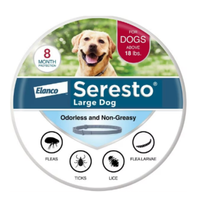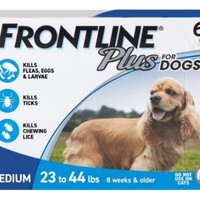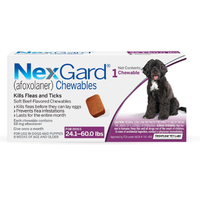What’s the safest flea treatment for dogs? A vet's guide
How to choose the safest flea treatment for dogs, according to an expert.

Choosing the safest flea treatment for dogs is an important task and we’re here to help you make that big decision. Fleas wreak havoc on your and your dog’s lives, causing itching and irritation that can lead to secondary infections.
As well as being a general nuisance, fleas can be dangerous to your dog and can even bite and transmit diseases to humans. They carry potentially fatal diseases and parasites and can cause life-threatening cases of anemia and pass on Bartonellosis disease. They can also spread tapeworms, a nasty intestinal parasite that causes diarrhea and weight loss.
The best flea treatments for dogs come in a variety of forms, from topical treatments to oral chews, and you might be weighing up the differences between flea medicine v collars. With so many options to choose from, we’re not surprised if you’re feeling overwhelmed, which is why vet Dr. Racine is here to help. Below, she’s explained all the treatments available and how safe they are for your dog:
Choosing the safest flea treatment for dogs
To choose the safest flea treatment for dogs, you’ll first need to consider the type of flea treatment that best fits your dog’s needs and lifestyle. Flea treatments are available as collars, oral tablets or chews, and topical spot-on treatments. All three types of flea treatment categories have products that are safe and effective, but they each have their own pros and cons. You’ll also need to consider your dog’s age, health status, and the manufacturer’s recommendations before you pick a product.
We recommend always choosing a prescription product as recommended by your veterinarian, so you know you’ll be getting something that is safe and effective for your dog. Your vet is also your best resource to help you pick a product that best fits your lifestyle and budget as well as your dog’s individual needs.
You might also want to learn how to remove a tick from your pet and why your flea treatment isn't working.

Flea collars for dogs
Many pet owners prefer to use collars as their flea treatment because this method is easy and mess-free. Some of the modern flea collar products even last as long as eight months, so you won’t have to remember to administer your dog’s flea treatment on a regular basis – a great plus for many busy families!
However, it is important to remember that not all flea collars are created equal. Many cheap over-the-counter flea collars are not safe or effective flea treatments and may not provide good protection against fleas. Before purchasing an over-the-counter product, be sure to research the best flea collars for dogs currently available on the market and check in with your vet to see what they recommend.
Flea collars also have some drawbacks. Because they rely on medication that spreads from the collar across your pet’s skin, they are not a good option for pets who swim or bathe frequently, as this will wash away the medication and shorten the life of the collar.
Be sure to check the manufacturer’s recommendations to find out how often your pet can safely be exposed to water while using the flea collar. Collars also pose a choking hazard if your pet chews the collar or becomes caught on anything, such as a branch while running outside. Look for collars with a built-in breakaway system to help minimize this risk, or consider another flea treatment option for pets that spend a lot of time outdoors.
This odorless collar will protect your dog from fleas, ticks, and lice, and lasts for eight months. Once you put it on your pup, the formula will start working within 24 hours and you’ll be pleased to hear that it’s grease-free.
Topical flea treatment for dogs
How do topical flea treatments work? Topical flea treatments are often seen as a safe flea treatment for dogs because many types of this medication are not absorbed systemically, meaning they do not cross the dog’s skin barrier or get absorbed into the bloodstream. This can be a safer option for dogs with a history of reactions to certain types of medications.
Topical flea treatments are typically applied every month or every three months, depending on the product, so pet owners need to be careful to remember to apply these products on time.
Like collars, these medications can be washed away if your pet swims or bathes frequently, so be sure to follow the manufacturer’s directions for use and consider an oral flea treatment if your pet is frequently exposed to water.
You’ll also need to be careful not to touch the area where the flea treatment was applied until it is fully dry, which usually takes about an hour after application. In rare cases, some dogs may have mild side effects such as local skin reactions at the site where the medication was applied, which may include hair loss, redness, itching, and scabbing.
This topical treatment lasts for 30 days and protects your pup against fleas, ticks, eggs, larvae, and chewing lice. It’s stored in your pet’s oil glands and is waterproof 24 hours after the application
Oral flea treatment for dogs
Oral flea treatments are easy to administer and typically offer one or three months of protection per dose. These flea treatment medications are usually flavored so most dogs actually enjoy taking them!
Many pet owners prefer this option because it is less messy compared to topical medication and does not wash away with swimming or bathing the way topical and collar flea treatments often do. These medications are safe and effective for most dogs, and side effects tend to be mild.
For dogs that do experience side effects, the most common symptoms are vomiting and diarrhea. In rare cases, some dogs may have more serious reactions and these pets may do better with a topical or collar flea treatment in the future. Pet owners will have to remember to give this medication every month or every 90 days, but because it’s easy to administer, most find it to be more appealing that topical medications.
The bottom line is that there are many safe and effective flea treatments available for your dog, and that is great news! You have many options to choose from depending on your lifestyle, budget, and personal preferences.
If you have questions about the best flea treatments for your dog, your veterinarian is an invaluable resource to provide product recommendations and guidance for you and your pup. Together, you and your vet team will undoubtedly find a safe and effective flea treatment that your whole family can feel comfortable with.
You might also want to read: Six ways to prevent fleas and topical flea treatment vs oral.
PetsRadar Newsletter
Get the best advice, tips and top tech for your beloved Pets
Dr. Elizabeth Racine is a small animal general practice vet covering all things pet health and wellness. Her special interests include veterinary behavior, nutrition, and internal medicine.
As a freelance writer, Dr. Racine has written content for major companies in the industry such as the American Kennel Club, Merck Animal Health, Bayer PetBasics, Elanco, and CareCredit. In her free time, Dr. Racine enjoys playing trampoline dodgeball, hiking with her beagle Dasher, and spending time with her three mischievous cats.
- Megan MilsteadStaff Writer




